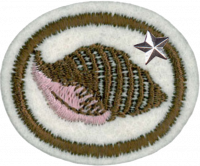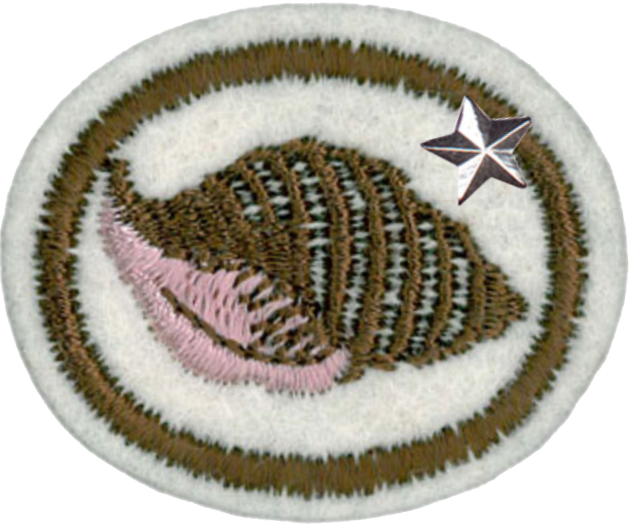Difference between revisions of "AY Honors/Shells - Advanced/Answer Key/es"
From Pathfinder Wiki
< AY Honors | Shells - AdvancedAY Honors/Shells - Advanced/Answer Key/es
(Created page with "</noinclude> ==Referencias== Category:Adventist Youth Honors Answer Book/es <noinclude>") |
(Updating to match new version of source page) |
||
| (15 intermediate revisions by 2 users not shown) | |||
| Line 1: | Line 1: | ||
| − | + | {{HonorSubpage}} | |
| − | |||
| − | {{ | ||
| − | |||
| − | |||
| − | |||
| − | |||
| − | |||
| − | |||
| − | |||
| − | }} | ||
| − | |||
| − | |||
| − | |||
<section begin="Body" /> | <section begin="Body" /> | ||
{{ansreq|page={{#titleparts:{{PAGENAME}}|2|1}}|num=1}} | {{ansreq|page={{#titleparts:{{PAGENAME}}|2|1}}|num=1}} | ||
| Line 32: | Line 19: | ||
{{ansreq|page={{#titleparts:{{PAGENAME}}|2|1}}|num=3}} | {{ansreq|page={{#titleparts:{{PAGENAME}}|2|1}}|num=3}} | ||
<noinclude></noinclude> | <noinclude></noinclude> | ||
| − | <!-- 3. | + | <!-- 3. Conocer los términos de la clasificación de los moluscos, conocer las características distintivas de cada uno y familiarizarse con varias especies de cada clase. --> |
| − | |||
{{clear}} | {{clear}} | ||
| Line 41: | Line 27: | ||
{{ansreq|page={{#titleparts:{{PAGENAME}}|2|1}}|num=4}} | {{ansreq|page={{#titleparts:{{PAGENAME}}|2|1}}|num=4}} | ||
<noinclude></noinclude> | <noinclude></noinclude> | ||
| − | <!-- 4 | + | <!-- 4 Distinguir entre moluscos unívalvos y bívalvos teniendo en cuenta las siguientes partes: --> |
<noinclude></noinclude> | <noinclude></noinclude> | ||
{{ansreq|page={{#titleparts:{{PAGENAME}}|2|1}}|num=4a}} | {{ansreq|page={{#titleparts:{{PAGENAME}}|2|1}}|num=4a}} | ||
| Line 92: | Line 78: | ||
{{ansreq|page={{#titleparts:{{PAGENAME}}|2|1}}|num=5}} | {{ansreq|page={{#titleparts:{{PAGENAME}}|2|1}}|num=5}} | ||
<noinclude></noinclude> | <noinclude></noinclude> | ||
| − | <!-- 5. | + | <!-- 5. Identificar a partir de conchas o dibujos y saber el significado de los siguientes términos lógicos de caracoles: --> |
<noinclude></noinclude> | <noinclude></noinclude> | ||
{{ansreq|page={{#titleparts:{{PAGENAME}}|2|1}}|num=5a}} | {{ansreq|page={{#titleparts:{{PAGENAME}}|2|1}}|num=5a}} | ||
| Line 213: | Line 199: | ||
{{ansreq|page={{#titleparts:{{PAGENAME}}|2|1}}|num=6}} | {{ansreq|page={{#titleparts:{{PAGENAME}}|2|1}}|num=6}} | ||
<noinclude></noinclude> | <noinclude></noinclude> | ||
| − | <!-- 6. | + | <!-- 6. Explicar el desarrollo de una concha. ¿Cuánto tiempo viven los moluscos? --> |
| − | |||
| − | |||
| − | |||
| − | |||
| − | |||
| − | |||
{{clear}} | {{clear}} | ||
| Line 231: | Line 211: | ||
{{ansreq|page={{#titleparts:{{PAGENAME}}|2|1}}|num=7}} | {{ansreq|page={{#titleparts:{{PAGENAME}}|2|1}}|num=7}} | ||
<noinclude></noinclude> | <noinclude></noinclude> | ||
| − | <!-- 7. | + | <!-- 7. Dar algunos datos sobre la vida de un caracol Strombus pugilis (conchas luchadora) y explicar la razón por la que éste molusco es llamado así. --> |
| − | |||
<noinclude></noinclude> | <noinclude></noinclude> | ||
| Line 238: | Line 217: | ||
{{ansreq|page={{#titleparts:{{PAGENAME}}|2|1}}|num=8}} | {{ansreq|page={{#titleparts:{{PAGENAME}}|2|1}}|num=8}} | ||
<noinclude></noinclude> | <noinclude></noinclude> | ||
| − | <!-- 8. | + | <!-- 8. Explicar las actividades del molusco broma. --> |
| − | {{: | + | {{:AY Honors/Shipworm/es}} |
<noinclude></noinclude> | <noinclude></noinclude> | ||
| Line 245: | Line 224: | ||
{{ansreq|page={{#titleparts:{{PAGENAME}}|2|1}}|num=9}} | {{ansreq|page={{#titleparts:{{PAGENAME}}|2|1}}|num=9}} | ||
<noinclude></noinclude> | <noinclude></noinclude> | ||
| − | <!-- 9. | + | <!-- 9. ¿Cómo se explica la distribución de los moluscos? --> |
| − | |||
<noinclude></noinclude> | <noinclude></noinclude> | ||
| Line 252: | Line 230: | ||
{{ansreq|page={{#titleparts:{{PAGENAME}}|2|1}}|num=10}} | {{ansreq|page={{#titleparts:{{PAGENAME}}|2|1}}|num=10}} | ||
<noinclude></noinclude> | <noinclude></noinclude> | ||
| − | <!-- 10. | + | <!-- 10. Nombrar dos moluscos que no tienen conchas. --> |
| − | |||
| − | |||
| − | |||
| − | |||
| − | |||
| − | |||
<noinclude></noinclude> | <noinclude></noinclude> | ||
| Line 264: | Line 236: | ||
{{ansreq|page={{#titleparts:{{PAGENAME}}|2|1}}|num=11}} | {{ansreq|page={{#titleparts:{{PAGENAME}}|2|1}}|num=11}} | ||
<noinclude></noinclude> | <noinclude></noinclude> | ||
| − | <!-- 11. | + | <!-- 11. Encontrar respuestas a las siguientes preguntas interesantes: --> |
<noinclude></noinclude> | <noinclude></noinclude> | ||
{{ansreq|page={{#titleparts:{{PAGENAME}}|2|1}}|num=11a}} | {{ansreq|page={{#titleparts:{{PAGENAME}}|2|1}}|num=11a}} | ||
| Line 293: | Line 265: | ||
{{ansreq|page={{#titleparts:{{PAGENAME}}|2|1}}|num=11f}} <!--T:68--> | {{ansreq|page={{#titleparts:{{PAGENAME}}|2|1}}|num=11f}} <!--T:68--> | ||
<noinclude></noinclude> | <noinclude></noinclude> | ||
| − | |||
<noinclude></noinclude> | <noinclude></noinclude> | ||
| Line 299: | Line 270: | ||
{{ansreq|page={{#titleparts:{{PAGENAME}}|2|1}}|num=11g}} <!--T:69--> | {{ansreq|page={{#titleparts:{{PAGENAME}}|2|1}}|num=11g}} <!--T:69--> | ||
<noinclude></noinclude> | <noinclude></noinclude> | ||
| − | |||
| − | |||
| − | |||
| − | |||
| − | |||
| − | |||
| − | |||
| − | |||
| − | |||
<noinclude></noinclude> | <noinclude></noinclude> | ||
| Line 328: | Line 290: | ||
{{ansreq|page={{#titleparts:{{PAGENAME}}|2|1}}|num=12}} | {{ansreq|page={{#titleparts:{{PAGENAME}}|2|1}}|num=12}} | ||
<noinclude></noinclude> | <noinclude></noinclude> | ||
| − | <!-- 12. | + | <!-- 12. Nombrar seis usos comerciales de las conchas (moluscos). --> |
| − | |||
| − | |||
| − | |||
| − | |||
| − | |||
| − | |||
| − | |||
<noinclude></noinclude> | <noinclude></noinclude> | ||
| Line 341: | Line 296: | ||
{{ansreq|page={{#titleparts:{{PAGENAME}}|2|1}}|num=13}} | {{ansreq|page={{#titleparts:{{PAGENAME}}|2|1}}|num=13}} | ||
<noinclude></noinclude> | <noinclude></noinclude> | ||
| − | <!-- 13. | + | <!-- 13. Realizar una de las siguientes actividades:<br>a. Personalmente encontrar y recolectar 40 especies de conchas que representan a las cinco clasificaciones. Hacer una lista de cada molusco con el lugar y la fecha en que fue encontrado, nombre común, nombre científico y la clase.<br>b. Hacer una colección de 50 especies de conchas que ha encontrado, recibido o comprado que representen las cinco clasificaciones. Hacer una lista de cada concha recogida de la siguiente manera: si la encontró personalmente, dar la información solicitada en el punto «a»; si la recibió o compró, dar el nombre de la persona de quien recibió la concha, el hábitat de la concha, la fecha de su adquisición, su nombre común, nombre científico y la clase. --> |
| − | |||
{{clear}} | {{clear}} | ||
| Line 352: | Line 306: | ||
<noinclude></noinclude> | <noinclude></noinclude> | ||
==Referencias== | ==Referencias== | ||
| − | |||
<noinclude></noinclude> | <noinclude></noinclude> | ||
| − | + | {{CloseHonorPage}} | |
Latest revision as of 00:33, 15 July 2022
Moluscos - Avanzado
Nivel de destreza
3
Año
1949
Version
29.11.2024
Autoridad de aprobación
Asociación General
1
Tener la especialidad de Moluscos.
Para consejos e instrucciones, véase Moluscos.
2
Definir el término «moluscos».
3
Conocer los términos de la clasificación de los moluscos, conocer las características distintivas de cada uno y familiarizarse con varias especies de cada clase.
4
Distinguir entre moluscos unívalvos y bívalvos teniendo en cuenta las siguientes partes:
4a
Concha
4b
Cuerpo del molusco
4c
Reproducción
4d
Movimientos
4e
Asegurando la alimentación
4f
Auto-preservación
5
Identificar a partir de conchas o dibujos y saber el significado de los siguientes términos lógicos de caracoles:
5a
Valva
5b
Ápice
5c
Apertura, orificio
5d
Biso
5e
Pie
5f
Mantel, manto
5g
Opérculo
5h
Nácar
5i
Epidermis
5j
Costillas
5k
Los dientes
5l
Líneas concéntricas
5m
Canal
5n
Espinas
5o
Espira
5p
Labios
6
Explicar el desarrollo de una concha. ¿Cuánto tiempo viven los moluscos?
7
Dar algunos datos sobre la vida de un caracol Strombus pugilis (conchas luchadora) y explicar la razón por la que éste molusco es llamado así.
8
Explicar las actividades del molusco broma.
9
¿Cómo se explica la distribución de los moluscos?
10
Nombrar dos moluscos que no tienen conchas.
11
Encontrar respuestas a las siguientes preguntas interesantes:
11a
¿Cómo están unidos los bívalvos y unívalvos a sus conchas?
11b
¿Cómo es controlado el color del molusco?
11c
¿Qué molusco tiene cuatro branquias?
11d
¿De qué animal del mar fue hecha la tinta india?
11e
¿Qué molusco hace girar un hilo de seda?
11f
¿Qué conchas se utilizaban para el dinero de tribus antiguas?
11g
¿Qué concha se considera sagrado por los tibetanos?
11h
¿De qué molusco se obtenía la tinta púrpura en los tiempos antiguos?
11i
¿Cuál es la fuente de las perlas? ¿Cómo se forman?
12
Nombrar seis usos comerciales de las conchas (moluscos).
13
Realizar una de las siguientes actividades:
- a. Personalmente encontrar y recolectar 40 especies de conchas que representan a las cinco clasificaciones. Hacer una lista de cada molusco con el lugar y la fecha en que fue encontrado, nombre común, nombre científico y la clase.
- b. Hacer una colección de 50 especies de conchas que ha encontrado, recibido o comprado que representen las cinco clasificaciones.
- Hacer una lista de cada concha recogida de la siguiente manera: si la encontró personalmente, dar la información solicitada en el punto «a»; si la recibió o compró, dar el nombre de la persona de quien recibió la concha, el hábitat de la concha, la fecha de su adquisición, su nombre común, nombre científico y la clase.


